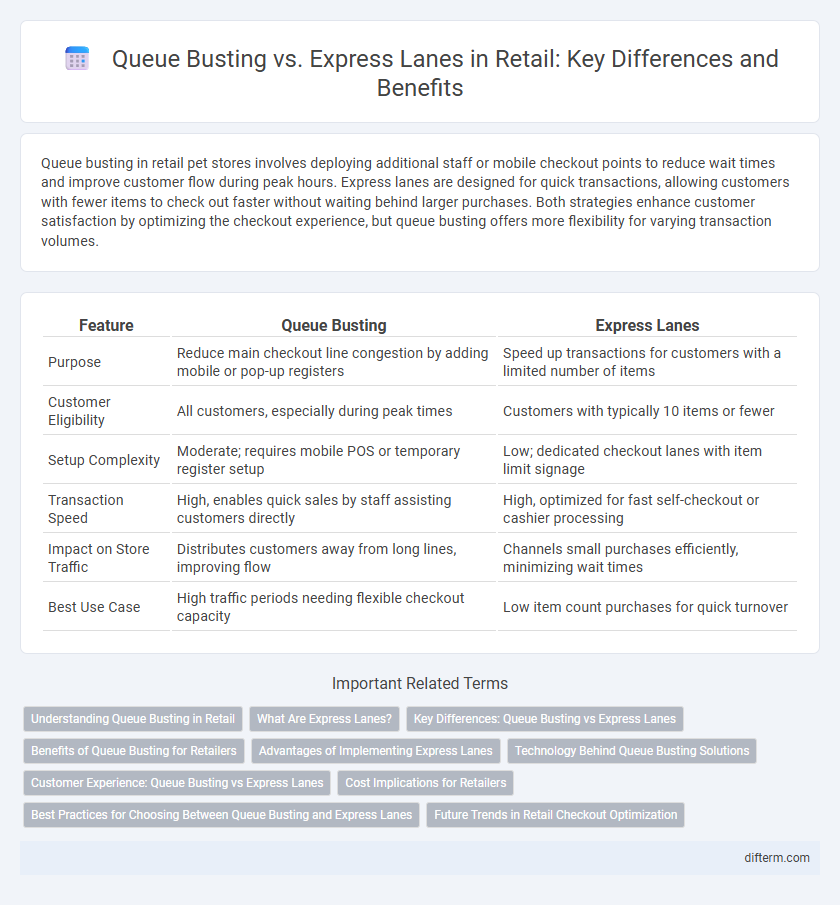Queue busting in retail pet stores involves deploying additional staff or mobile checkout points to reduce wait times and improve customer flow during peak hours. Express lanes are designed for quick transactions, allowing customers with fewer items to check out faster without waiting behind larger purchases. Both strategies enhance customer satisfaction by optimizing the checkout experience, but queue busting offers more flexibility for varying transaction volumes.
Table of Comparison
| Feature | Queue Busting | Express Lanes |
|---|---|---|
| Purpose | Reduce main checkout line congestion by adding mobile or pop-up registers | Speed up transactions for customers with a limited number of items |
| Customer Eligibility | All customers, especially during peak times | Customers with typically 10 items or fewer |
| Setup Complexity | Moderate; requires mobile POS or temporary register setup | Low; dedicated checkout lanes with item limit signage |
| Transaction Speed | High, enables quick sales by staff assisting customers directly | High, optimized for fast self-checkout or cashier processing |
| Impact on Store Traffic | Distributes customers away from long lines, improving flow | Channels small purchases efficiently, minimizing wait times |
| Best Use Case | High traffic periods needing flexible checkout capacity | Low item count purchases for quick turnover |
Understanding Queue Busting in Retail
Queue busting in retail involves deploying extra staff or mobile checkout stations during peak times to reduce customer wait times and improve the shopping experience. This strategy targets long lines by proactively addressing congestion before it builds, unlike express lanes which separate customers by item count for faster processing. Effective queue busting enhances operational efficiency and increases customer satisfaction by minimizing checkout bottlenecks.
What Are Express Lanes?
Express lanes are designated checkout counters in retail stores designed to expedite transactions for customers with a limited number of items, typically 10 to 15 or fewer. These lanes prioritize speed by limiting the number of products, making them ideal for quick purchases and reducing overall wait times. Unlike queue busting, which involves deploying additional cashiers during peak hours to open more lanes, express lanes specifically target small-basket shoppers to streamline the checkout process.
Key Differences: Queue Busting vs Express Lanes
Queue busting involves deploying additional staff or mobile checkout units throughout the store to reduce wait times during peak hours, enhancing customer flow and satisfaction. Express lanes are designated checkout counters with item limits, designed to expedite purchases for customers with fewer products, thereby minimizing overall transaction times. The key difference lies in queue busting's flexibility to alleviate congestion anywhere in the store, while express lanes strictly regulate purchase quantities to speed up checkout.
Benefits of Queue Busting for Retailers
Queue busting in retail enhances customer satisfaction by reducing wait times and increasing transaction speed, directly boosting sales volume during peak hours. Compared to express lanes, queue busting provides more flexibility for all customers, allowing retailers to optimize staff allocation and improve overall operational efficiency. This strategy also helps mitigate cart abandonment and encourages impulse purchases, driving higher revenue and better customer retention.
Advantages of Implementing Express Lanes
Express lanes significantly reduce customer wait times by dedicating specific checkout points for small or quick purchases, thus increasing overall store efficiency. They enhance the shopping experience by streamlining traffic flow and minimizing congestion during peak hours. Retailers benefit from improved customer satisfaction and potentially higher sales due to faster transaction processing.
Technology Behind Queue Busting Solutions
Queue busting solutions leverage advanced AI-powered analytics and real-time sensor technology to dynamically identify and serve customers with smaller baskets across multiple checkout points, reducing congestion and wait times. Express lanes utilize barcode scanning systems and transaction speed optimization tools designed to expedite purchases with limited items, strictly enforcing item count restrictions. Both technologies integrate with POS systems and mobile apps to provide seamless customer experiences while maximizing throughput efficiency.
Customer Experience: Queue Busting vs Express Lanes
Queue busting enhances customer experience by reducing wait times directly on the sales floor through mobile checkout or additional staff deployment, creating a seamless and personalized shopping journey. Express lanes streamline the checkout process for customers with limited items, minimizing perceived wait time while improving overall store efficiency. Both strategies improve customer satisfaction but queue busting offers a more flexible and dynamic solution tailored to peak shopping moments.
Cost Implications for Retailers
Queue busting reduces labor costs by deploying staff strategically during peak times to manage lines, whereas express lanes require investment in additional checkout infrastructure and increased staffing. Queue busting improves customer throughput with minimal capital expenditure, making it cost-effective for retailers with fluctuating traffic. Express lanes demand continuous operational expenses but enhance customer experience by offering faster service for small basket shoppers, potentially increasing overall store efficiency.
Best Practices for Choosing Between Queue Busting and Express Lanes
Queue busting enhances customer experience by deploying mobile point-of-sale devices to reduce wait times during peak hours, enabling more flexible staff allocation. Express lanes are effective for maximizing throughput with clearly defined product limits, catering to shoppers with smaller baskets for faster transactions. Retailers should analyze transaction data and customer flow patterns to select the optimal solution that balances speed, staff efficiency, and shopper satisfaction.
Future Trends in Retail Checkout Optimization
Future trends in retail checkout optimization highlight the increasing adoption of AI-driven queue busting systems that dynamically allocate staff to reduce wait times and improve customer experience. Express lanes remain vital for small basket transactions, but seamless integration with mobile payments and biometric authentication is reshaping their efficiency. Retailers investing in real-time analytics and automated checkout technologies are positioned to enhance throughput while minimizing operational costs.
queue busting vs express lanes Infographic

 difterm.com
difterm.com